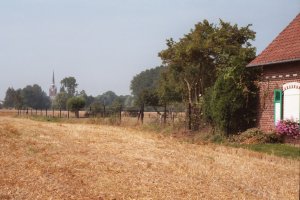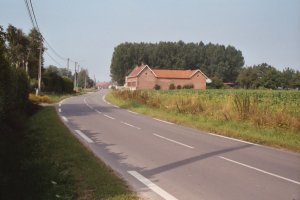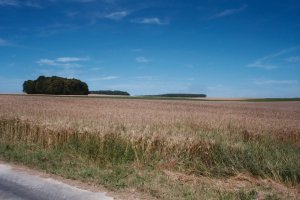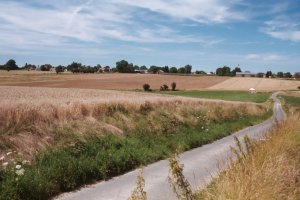
On Saturday 6th February 1915, the task of recruiting more than 700 men began at Accrington. First to enlist as a Gunner with the number L/1 was George Nicholas Slinger. Recruitment in other East Lancashire towns began the following Monday. Provisional command of the Brigade went to Thomas Purvis Ritzema. The departure of the Accrington Pals for Caernarvon on 27th February gave fresh impetus to recruitment and by 6th March the Brigade was complete except for its Ammunition Column. Of its four batteries, A and B were based in Accrington, C and D in Burnley. Even though the Brigade was converted in December 1915 from howitzers to quick-firing 18-pounder field guns, it would always be known locally as 'The Howitzers'.
Large crowds ignored the rain that fell on the morning of Saturday, 5th June 1915 to see the Brigade - now the 158th (Accrington & Burnley) Brigade - leave its home towns for Weeton Camp near Kirkham. A few days later, Harwood was to remark that 1,300 of the 2,000 men that formed the Pals and Howitzers came from Accrington. Even taking Accrington to include its districts, Harwood surely exaggerated the contribution made by his town. It was, nevertheless, a remarkable achievement. 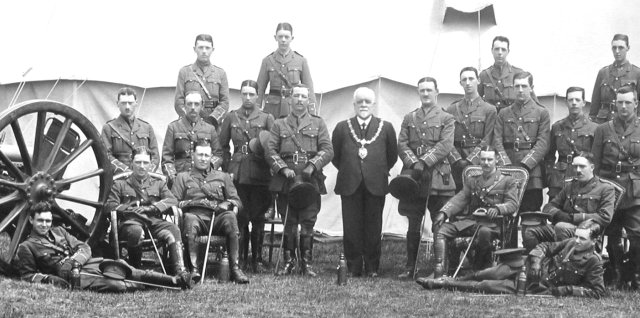 The Mayor of Accrington, Captain John Harwood, with officers of the 158th (Accrington & Burnley) Brigade, R.F.A. at Weeton Camp, 12th June 1915. Lt.-Col. Thomas Purvis Ritzema is standing on the Mayor's left. Photograph by kind courtesy of Lancashire County Library, Accrington Local Studies Library. After two months at Weeton, the Brigade left for Masham where it took its place in 35th Division alongside the 157th, 159th, and 163rd Artillery Brigades, and 104th, 105th and 106th Infantry (Bantam) Brigades. Three weeks later, the artillery moved again, this time for gunnery practice at Bulford on Salisbury Plain. 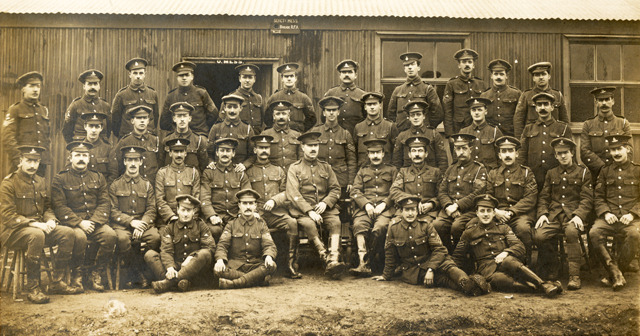 Warrant officers, staff sergeants and sergeants, Accrington & Burnley Howitzer Brigade, Bulford Camp, January 1916. Click to enlarge left, centre or right
Lt.-Col. Percy Harrison Fawcett - these days better remembered as the South American explorer who disappeared in 1925 - took over command of 158th Brigade on 27th January 1916, one day after orders had been received to embark for overseas.
158th Brigade went into the line at Laventie towards the end of March 1916. A letter published in the Accrington Gazette gives some idea of the conditions under which the men lived: "When I think of the first six weeks we had in France.....rain, snow, and frost, and all our horses in the open, and the boys with fingers swollen and torn, having to untie the head ropes, standing the while up to the knees in slime and mud, chilled to the bone, after sleeping in a too-well-ventilated barn, with their boots under the blankets so as to keep them from being frozen in the morning - chilblains on their feet like over-ripe tomatoes - and yet cheerful in spite of all!...." The Brigade suffered its first fatality in action when 2/Lt. Eric Balderson was killed by enemy shellfire directed against C/158th in the morning of 28th March. Over 14th/15th April, 158th side-stepped to la Croix Barbet. It was here that it made its first significant contribution when the Brigade's prompt support and accurate shooting played a major part in breaking up a local German offensive on the evening of 29th May; 2/Lt. Edmund Harwood - a nephew of the mayor - and 2/Lt. George Slinger were commended for devotion to duty at their Observation Post; L/603 Cpl. W.E. Bulley and L/308 Gnr. W. Rucastle (both of B/158th) were commended for gallantry in repairing wires under heavy fire. In a letter to Harwood, Fawcett wrote that the batteries "have been in the line for some time, as you know, and have all had their baptism of fire, having done and doing all the time extremely well to the efficiency of the Brigade, and the undoing of the Boche." By this time, the Brigade had undergone its first reorganizations. On 26th May, its Ammunition Column became No.2 Section, 35th Division Ammunition Column; the following day, D/158th - one of the two Burnley batteries - left to become B/163rd in order to accommodate a howitzer battery. Meanwhile, the artillerymen had begun to receive 'comforts' paid for by their home towns. These included a gramophone and 80 records, 1½ gross safety razors, 6 sets of cricket and football gear, 200 woollen shirts, 800 pairs of socks, and 100 woollen undershirts. C/158th was unfortunate to be the only one of the four batteries not to be relieved over 17th-20th June. Instead it was left in line to support a local attack made on 30th June by 39th Division and designed to divert the enemy's attention from the imminent offensive on the Somme. Although the 12th and 13th Royal Sussex broke into three lines of the enemy's defences, they were unable to hold on and were forced to fall back to their own lines. The artillery received a glowing letter of praise for their work, though Capt. Thomas Riley, commanding C/158th, thought it more glowing than the situation deserved. One of the men under Riley's command was awarded the Military Medal for repeatedly repairing telephone wires under heavy shell and machine gun fire. On 19th July 1916, 158th Brigade moved into the line at Maricourt on the Somme. Covering the front south of Guillemont, the Brigade was in continuous action from 20th July until 11th August. On 30th July, its four batteries fired a total of 4,287 rounds in support of an attack made by 89th and 90th Infantry Brigades on a line south of Delville Wood to 500 yards south of Falfemont Farm. The following day, the batteries came under heavy shellfire after being spotted by enemy aeroplanes. Capt. Frederick Stevens of D/158th was killed when he left the safety of a dugout to help two wounded drivers of an ammunition wagon; Lt. G. Youl described what happened: "An empty ammunition wagon and team, were passing along the road in rear of the Battery, when they were hit by a shell, which killed three horses and wounded two of the drivers. As soon as Captn. Stevens saw this, he ran to help the drivers; at great risk to himself, as the shelling continued in the neighbourhood. Another shell burst quite close to him and knocked him over, wounding him in the spine. He only regained consciousness once and his first enquiry then was about the safety of the drivers."
A further 4,056 rounds were expended on 7th August in preparation for an attempt to capture Guillemont on the 8th. The Brigade was relieved on the 12th, returning to the line south of Montauban on the 17th. It remained there covering the front north of Guillemont, until 3rd September when it moved to the Arras front. In a further reorganization on 9th September 1916, C/158th - the one remaining Burnley battery - left the Brigade, and was split between 157th and 159th Brigades, its place being taken by D/163rd. A/158th and B/158th - the two Accrington batteries - were reinforced by sections from B/163rd (originally the Burnley battery, D/158th!). On 14th September, 158th Brigade received a number of awards for gallantry on the Somme. In November 1916, General Headquarters decided to take two artillery brigades out of each division to be formed into Army Field Artillery (A.F.A) Brigades which could be used to reinforce sectors of the front without breaking up the divisional structure. Although 158th Brigade's days were now numbered, the two Accrington batteries would survive intact. On 8th January 1917, A/158th left to become C/48th A.F.A.; two days later, B/158th left to become C/64th A.F.A. C/48th went into the line at Beaurains on 20th March 1917. The battery took part in the bombardment that opened the Battle of Arras and supported the infantry attacks that followed throughout April and May. The Military Cross was awarded to Capt. D.R. Worsley (ex-D/158th) in June, and the Military Medal to L/645 Bdr. Roland Stott (ex-A/158th) in August. As October drew to a close, 48th A.F.A. Brigade entrained for Ypres. The Brigade war diary gives a vivid description of the appalling conditions under which the artillerymen had to work in the Poelcapelle sector: 1st November 1917 The German Michael Offensive in the spring of 1918 saw 48th A.F.A. Brigade heavily engaged on the Somme front over 27th and 28th March. The Brigade was again in action the following month during the Battle of the Lys (Hazebrouck). Awards of the Military Medal were made in April to L/454 Dvr. Robert Taylor, and L/112 Gnr. Emmanuel Kenyon (both ex-A/158th). C/64th went into the line at Maroeuil on the night of 7th/8th February 1917. It fought throughout the Battle of Arras before moving to Ypres on 20th May. Casualties mounted as the Third Battle of Ypres ground on; in the 6 months up to 31st October, C/64th had 2 officers and 23 other ranks killed or missing, and a further 3 officers and 39 other ranks wounded. Between 1st April and 31st October 1917, L/201 Bdr. Thomas Flannigan received a Bar to his Military Medal; L/389 Sgt. Ted Crawshaw, L/199 Sgt. Richard Smithies, L/625 A/Bdr. Robert Higgin and L/610 Gnr. H. Ward (all ex-B/158th) were awarded the Military Medal. On 30th March 1918, 64th A.F.A. Brigade completed a move to new positions on the north bank of the Lys river. Ten days later, the German Georgette Offensive was launched on the Lys. In a remarkable coincidence, the Brigade - with its Accrington battery - joined the Accrington Pals in the desperate fighting east of Hazebrouck on 12th-13th April. © Andrew C Jackson 2004, 2014. Compiled from TNA documents WO95/295, WO95/455, WO95/2474, WO138/51, WO339/27229, WO374/57794, "The British Campaign in France and Flanders 1916" by Arthur Conan Doyle, "The History of the 35th Division in the Great War" by Lt.-Col. H.M. Davson, "History of the Royal Regiment of Artillery, Western Front 1914-18" by Gen. Sir Martin Farndale, KCB, "Exploration Fawcett" by Col. P.H. Fawcett; "Battle Tactics of the Western Front" by Paddy Griffith, the Long, Long Trail, issues of the Accrington Gazette, Accrington Observer & Times and Lancashire Evening Telegraph, and with the kind help of Michael Ritzema, Catherine Duckworth and Helen Barrett. |

